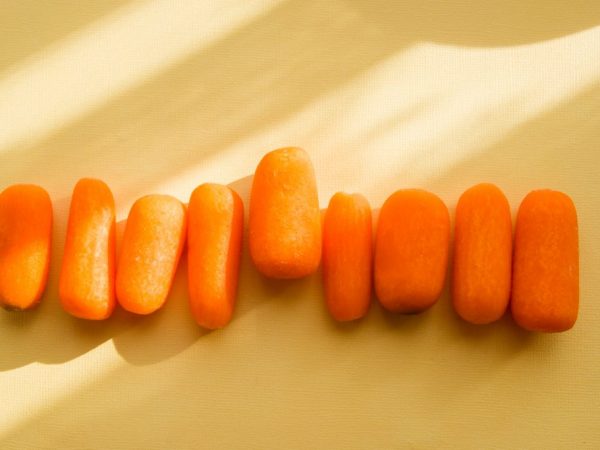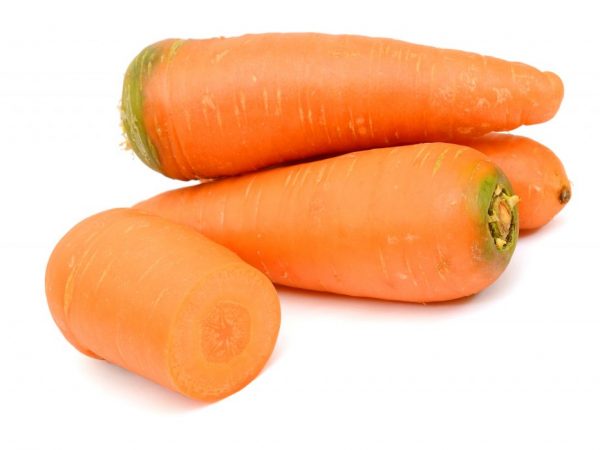Features of Shantane carrots
Shantane carrots are unpretentious in care, have a good yield and high taste. Another name for the variety is Chantenay 2461 carrot. It is in the top 10 of the best varieties for growing both in large areas and in small areas.

Features of Shantane carrots
Description of carrots
Shantane carrots are medium-sized varieties. It matures in 110 days. From 1 sq. m harvested about 9 kg of the crop.
The culture is planted in places with different climatic conditions and soil composition. The fruit does not crack, defects are extremely rare.
Shantane carrots are cone-shaped with a blunt end. The length of the fruit reaches 15 cm, and the width is up to 6 cm. The average weight is 200 g. The vegetable is completely in the ground. Shantane leaves have a spreading shape, bright green.
Description of Shantane carrots:
- bright orange color;
- practically not prominent core part;
- juicy and dense pulp;
- sweet taste (sugar content up to 10%).
Characteristics of the subspecies of culture:
| Variety | Ripening period | Weight (g) | Sugar content (%) | The amount of carotene (per weight 100 g) | Yield level (c / ha) |
| Shantane 5 | mid-season | 190 | Until 6 | 12,5 | Up to 567 |
| Comet | mid-season | 160 | Up to 8 | 24,9 | 298 |
| Carrot variety Shantane Royal | mid-season | 180 | 8,8 | 13,8 | 800 |
| Royal | mid-season | 200 | 6,9 | 15 | 300 |
| Courage Rouge 2 | early maturing | 120 | 10,5 | 24 | 378 |
Kuroda Shantane carrots are another vegetable variety that has a large harvest (up to 0.5 kg). Caring for the Kuroda variety is the same as for Shantane.
Growing
According to the characteristics, the Shantane carrot variety takes root well in any soil composition. But for high yields, there are requirements that must be met. The climate of Siberia is well suited.
The soil
For this variety, soils are good, which include sand. Ash is added to the ground before planting (1 bucket per 1 sq. M). It grows in places where other crops were previously planted: tomatoes, potatoes, onions or cabbage. In places where parsley and dill were previously grown, it is better not to plant: the plant does not take root.
The soil is inspected so that there are no weeds and remnants of previous vegetables. A couple of days before planting, the earth is dug up and watered abundantly.
Top dressing
Shantane carrots take root in heavy soil, but at the same time it must be fertilized. The roots of the plant feed on everything in the earth, so it is better to use natural substances.
Fertilized with superphosphate mixed with legumes and beet tops (sometimes siderates are added). This mixture is poured with water and allowed to settle so that it ferments. At the first appearance of sprouts, substances containing nitrogen are added, and later - potassium.
Sowing
There should be at least 20 cm between the rows. The depth of the planting pit is 2 cm. The plot should be well lit and ventilated. The plant is frost-resistant.
Shantane carrot variety bears fruit twice under good conditions:
- Carrots, Shantane (Sakata) seeds, which were planted in winter and spring. Ripens in June, used for vitamin supplementation.
- Harvest stored in winter. Sown in June, harvest in September.
This technology is used for the further sale of vegetables. Vegetable growers usually sow the crop once. Sometimes the seeds of the Shantane 2461 variety are sown on cold ground.
Care

Carrots are not afraid of drought
The culture is resistant to drought and frost, since the central taproot is able to germinate up to 2 m. This helps the plant to feed and obtain nutrients on its own. Top dressing is done only with weak vegetables and on unfavorable soils.
Loosening and mulching
Loosening is an important care element in the first time after sowing. Before the rows close, they are regularly loosened.
This helps to avoid weeds and dry crust on the soil. Mulching is optional.
Thinning
Due to the large fruits, there is not enough space for the vegetable. For this purpose, thinning is carried out.
- It is carried out in one run immediately to the desired distance - up to 5 cm;
- Performed in 2 passes. Initially, a small space is left between the shoots (2 cm), and later every second fruit is pulled out.
The main goal is not to harm neighboring plants. In order not to perform thinning, you need to plant seeds at a distance of 2 cm from each other.
Harvesting and storage of crops
Harvesting is carried out all summer, and especially during the germination period (110 days). Harvesting is carried out during dry climates. They try to pull out the first leaves with their hands, if the tops are torn, use additional equipment: a pitchfork, a shovel.
Algorithm of actions:
- cut off the tops;
- do not keep the root crop in the sun: it will become lethargic and lose its taste, transferred immediately to a cool place;
- in a day they are transferred to a cool basement room.
Necessary conditions for storing the crop:
- humidity - 90-95%;
- temperature regime - from 0 ° С to 10 ° С;
- storage in boxes and plastic bags;
- shelf life - up to 8 months.
Diseases and pests
A common parasite for Shantane carrots is the carrot fly. Symptoms are swirling tops. With proper crop care, this pest is not terrible. Habitat - thick, weeds, moist soil. For the fight, special drugs are used. Moles, slugs and other pests also harm the plant.
Treatment of plants with a solution of Bordeaux liquid excludes the appearance of fungal diseases. For example, phomosis and alternaria.
Conclusion
The Shantane carrot variety is resistant to cold, disease and adverse conditions. Not capricious, bears fruit well and has a presentation.
With proper care and sowing, the fruits grow large and tasty. The crop has a long shelf life - up to 8 months. It is consumed in natural and finished form.


